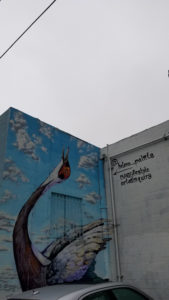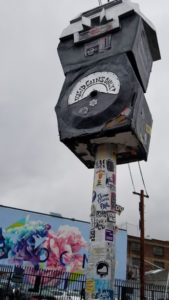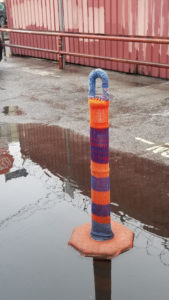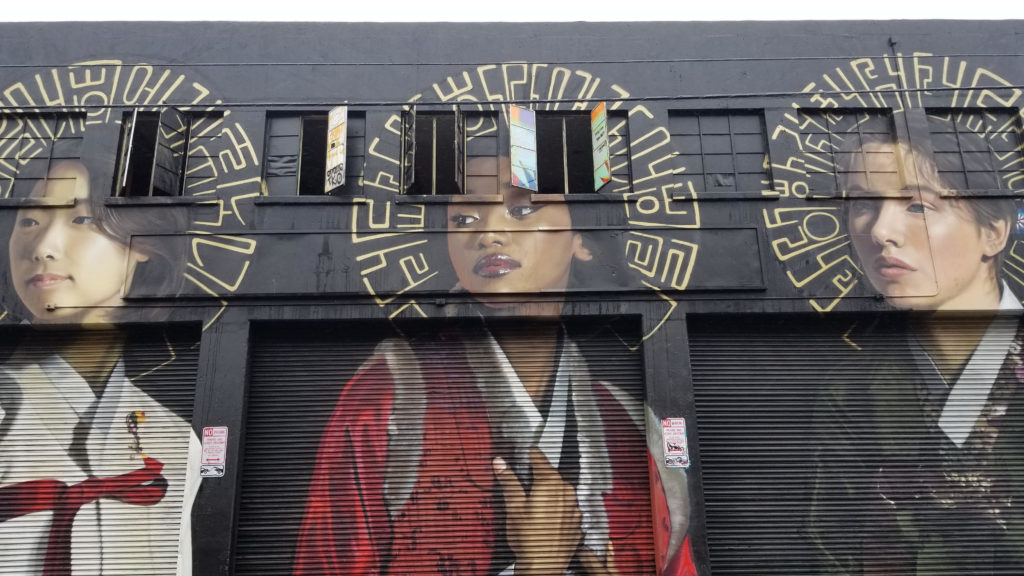by Heidi Massey, ’22
Standing in sharp contrast to the pristine Cathedral of Our Lady of Angels our class had visited earlier that day, our January 17th tour of L.A. Graffiti Arts opened my eyes to the intricate world of graffiti. After meeting our tour guide in L.A.’s arts district, we began our exploration of its ever-changing graffiti scene. I was admittedly skeptical coming into the tour, my narrow concept of graffiti consisting mainly of images of vandalism, tagging, and destruction of property.  However, my notion of graffiti was challenged and changed as I and others around me experienced it in a new way. I began to view graffiti not as a lawless activity for wild teenagers, but an elaborate and complex artform. From hand painted works to those created using only spray cans, from works by amateurs to the infamous UTI crew, from towering sculptures to metal sheets nailed to power poles, the downtown L.A. arts district boasts hundreds of displays of urban art, many of which we had the privilege to see.
However, my notion of graffiti was challenged and changed as I and others around me experienced it in a new way. I began to view graffiti not as a lawless activity for wild teenagers, but an elaborate and complex artform. From hand painted works to those created using only spray cans, from works by amateurs to the infamous UTI crew, from towering sculptures to metal sheets nailed to power poles, the downtown L.A. arts district boasts hundreds of displays of urban art, many of which we had the privilege to see.
Unlike artistic works our class has seen in museums, the art we encountered on our tour lacked permanency; even the most elaborate and breathtaking works risk being destroyed by another artist or covered by city workers. While some graffiti is legal and commissioned by building owners, it is just as often done illegally. Our tour guide, for example, a graffiti artist himself, only engages in legal art. Other artists, though, may refuse to do any legal work whatsoever. To test whether building owners are likely to take issue with graffiti on their property, artists strategically “throw up” a simple design or word on their desired wall. If their graffiti is covered, they move on to a different location. If it remains, they utilize the space to create a more complex work. Once completed, a work’s fate is left in the hands of building owners, graffiti clean-up crews, and other graffitists. Some pieces last for months, even years, while others are painted over within days, or “dissed” with the spray paint of other artists.

 Graffiti culture, however, encompasses more than just paint on a wall. On our tour we saw mobile-like creations hanging from power lines, traffic cones with knitted coverings, a larger than life parking meter, and even a metal cage repurposed as a “piñata petting zoo.” No matter how clever the creation, urban art is constantly vulnerable to destruction, setting it apart from the ways in which other art is preserved.
Graffiti culture, however, encompasses more than just paint on a wall. On our tour we saw mobile-like creations hanging from power lines, traffic cones with knitted coverings, a larger than life parking meter, and even a metal cage repurposed as a “piñata petting zoo.” No matter how clever the creation, urban art is constantly vulnerable to destruction, setting it apart from the ways in which other art is preserved.
One location we visited where graffiti is relatively safe from harm is the outside of a warehouse-like space called the Container Yard. Here, renowned graffiti artists from all over the world are recruited to paint huge, beautiful murals. Once painted, murals are only left up for a few years. The space is constantly being recycled to allow artists to paint new murals over the old. Though the destruction of these murals is seemingly tragic, this “out with the old” concept is very much demonstrative of graffiti arts as a whole.
Graffiti is nothing like any of the art forms we have seen during our time here. It is widely unstructured, ungoverned, and thrives on being subversive in nature. So, the question remains: given graffiti’s chaotic and sometimes illegal nature, can it still be considered art? My answer is yes. Though art manifests itself in countless different forms, I believe that it all comes from a desire to create something of importance, something moving. I think that this desire is at the forefront of graffiti artists’ motives. Not all art is good art, just as not all good graffiti is good graffiti, but our tour opened my eyes to the good and praiseworthy aspects of urban art.

We use cookies to improve your experience on our site. By using our site, you consent to cookies.
Websites store cookies to enhance functionality and personalise your experience. You can manage your preferences, but blocking some cookies may impact site performance and services.
Essential cookies enable basic functions and are necessary for the proper function of the website.
These cookies are needed for adding comments on this website.
Statistics cookies collect information anonymously. This information helps us understand how visitors use our website.
Google Analytics is a powerful tool that tracks and analyzes website traffic for informed marketing decisions.
Service URL: policies.google.com